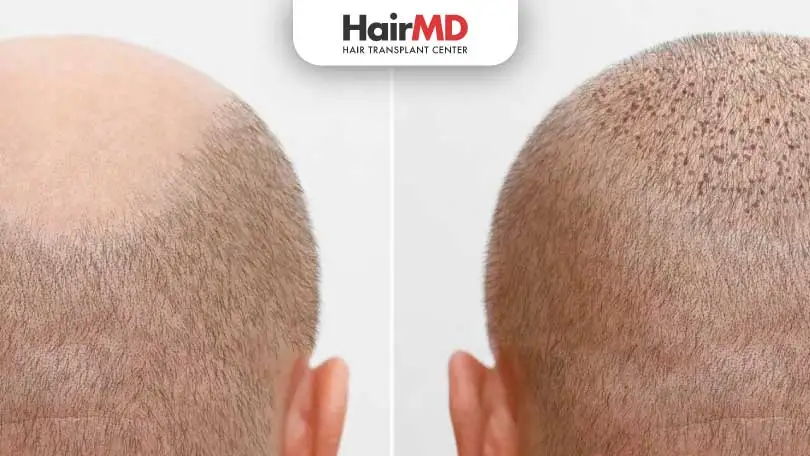17th Oct, 2024

What’s covered in the article?
- Understanding Hair Transplant Results: A Patient’s Guide
- Hair Transplant Techniques
- Hair Transplant Results: Risks and Side Effects
- Managing Patient Expectations
- Post-Operative Care
- Conclusion
Understanding Hair Transplant Results: A Patient’s Guide
Hair transplants have emerged as a sought-after solution for individuals grappling with hair loss. If you’re considering this procedure, it’s essential to comprehend the journey your transplanted follicles will undertake from the initial surgery to the ultimate results.
This article provides a comprehensive overview of hair transplant results, focusing on graft survival, the shedding phase, the regrowth phase, and managing patient expectations. Additionally, we delve into the latest techniques, potential risks, and post-operative care.
Hair Transplant Techniques
In recent years, hair transplant methods have evolved significantly. Two popular techniques are Follicular Unit Transplantation (FUT) and Follicular Unit Extraction (FUE). While FUT involves removing a strip of scalp, FUE extracts individual hair follicles, minimizing scarring and recovery time. Both techniques have their benefits, and your dermatologist will recommend the best option based on your specific needs.
Graft Survival and Initial Growth
Post-transplant, the grafts start their journey by acclimating to their new environment. Initially, you may observe some hair growth as the grafts settle. This early phase, lasting about three weeks, is just the start of the process.
The Shedding Phase
Between three to six weeks after the transplant, the shedding phase occurs. This is a normal part of recovery, where transplanted hairs fall out as the follicles enter the telogen (resting) phase. The extent of shedding varies among individuals, with some experiencing full shedding and others minimal. This phase is temporary and a natural part of the hair lifecycle.
The Regrowth Phase
Approximately two months post-procedure, the regrowth phase begins. New hairs emerge gradually, and by six to seven months, noticeable regrowth is visible. Hair begins to thicken, and the hairline becomes more defined. Each patient’s regrowth timeline is unique, with some seeing earlier results than others.
Achieving Full Results
While initial results are evident by six to seven months, complete regrowth can take up to a year or eighteen months. Patience is crucial as hair continues to thicken and mature over time.
Managing Patient Expectations
Understanding the timeline and phases of hair transplant recovery is vital for setting realistic expectations. The recovery process typically involves several stages, starting with the immediate post-operative period where care must be taken to protect the grafts. Swelling and redness are common during the first few days, followed by a phase where the transplanted hair may temporarily shed before regrowth begins.
Over the months, you can expect gradual improvements as the new hair follicles establish themselves and start to produce healthy hair. Open communication with your dermatologist or hair transplant specialist is essential to guide you through the process and address any concerns. They can provide personalized advice on aftercare and manage any side effects, ensuring that you achieve the best possible results from your procedure.
Hair Transplant Results: Risks and Side Effects
Like any surgical procedure, hair transplants come with potential risks. These may include infection, scarring, and temporary numbness. Infection can occur if the surgical site is not properly cared for, which might lead to redness, swelling, and discomfort. Scarring, although generally minimal and often hidden by hair, can still be a concern for some individuals.
Temporary numbness is usually due to nerve trauma during the procedure and typically resolves on its own over time. It’s important to discuss these risks with your specialist, who can provide detailed information based on your specific case. Following their advice on post-operative care is crucial to mitigate complications and ensure a smooth recovery process.
Post-Operative Care
Proper post-operative care can significantly influence the success of your hair transplant. This includes avoiding strenuous activities, protecting your scalp from the sun, and following prescribed medication routines. Using gentle shampoos and avoiding harsh styling products can also support the healing process.
Lifestyle Changes to Support Hair Health
In addition to post-operative care, lifestyle changes can enhance transplant success. A balanced diet rich in vitamins and minerals, regular exercise, and stress management can promote overall hair health. It’s also advisable to avoid smoking and excessive alcohol consumption, as these can impede hair growth.
Do You Know?
Nearly 250 Patients Visit HairMD
Everyday For Various Hair Concerns?
(You are one click away from flawless skin)
Meet Our Dermatologists
Conclusion
Hair transplants offer a promising path to hair restoration, but understanding the phases—from graft survival and shedding to regrowth—is critical for a satisfying experience. With patience, expert guidance, and proper care, you can achieve your desired results. For personalized advice, always consult with your healthcare provider.
By being informed and prepared, you can navigate your hair transplant journey with confidence, knowing what to expect and how best to care for your new hair.
Further Reading
How to Stop Hair Shedding After an Accident?
Explore the effects of trauma on hair, treatments, and tips for recovery and regrowth after a stressful incident.
Is Hair Transplant Right for You? | Guide for Patients
Discover hair transplant methods, eligibility for the procedure, and key tips for successful hair restoration from HairMD.
Know the Benefits of Mesotherapy for Hair Loss
Learn how mesotherapy helps treat hair loss and promotes healthier, thicker hair!
How to Grow Hair Faster | Hair Growth Cycle and Tips
“Explore how lifestyle factors can lead to hair loss. Learn about the impact of diet, stress, and habits on your hair health and how to make positive changes.”
Have thoughts? Please let us know
We are committed not only to treating you, but also educating you.











